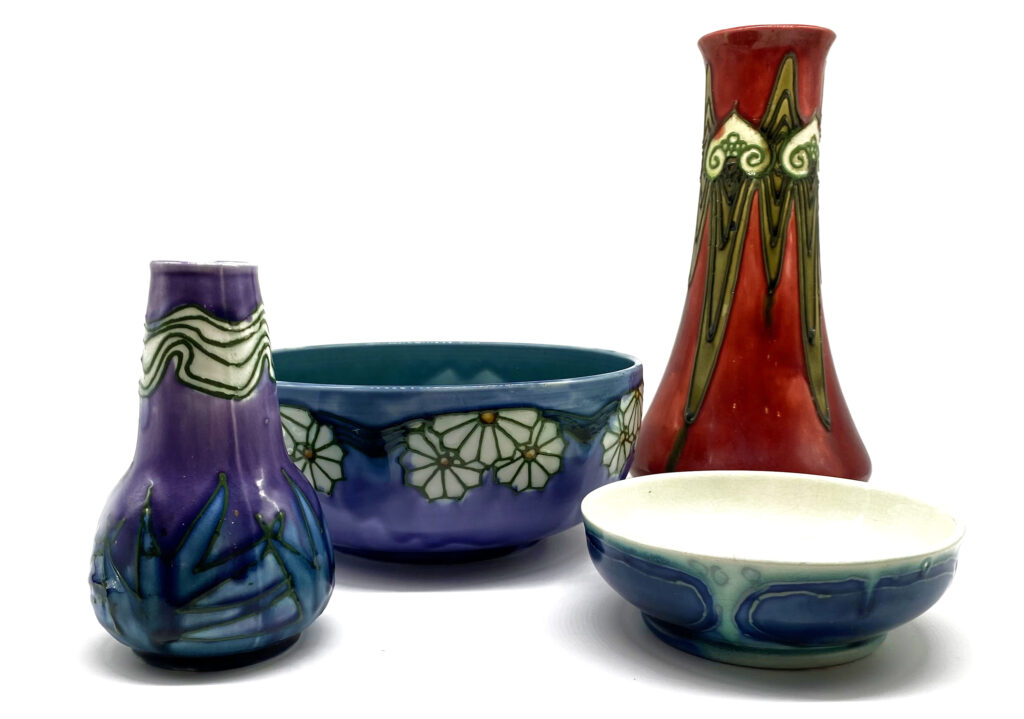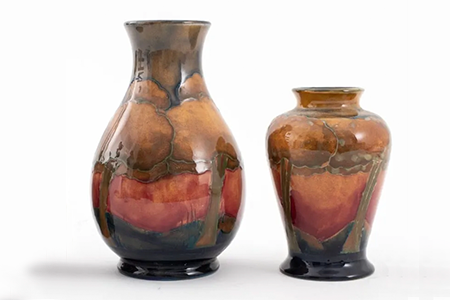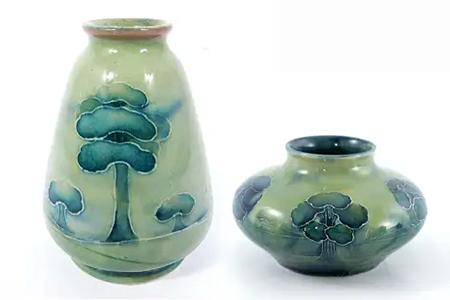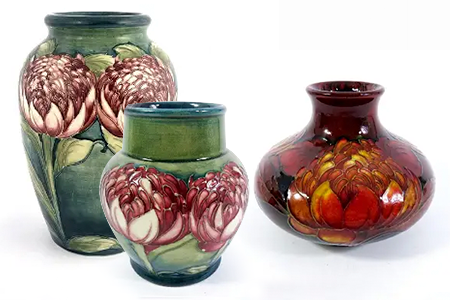Boch Frères Keramis
Boch Frères Keramis was founded in 1841 by brothers, Eugene (1809-1898) and Frédéric Victor Boch (1817-1920), and their brother-in-law, Jean-Baptiste Nothomb (1805-1881), in La Louviere, Hainault (St. Vaast), Belgium, after its separation from Luxembourg.
Their faience manufacturing developed very fast (faience, a term referring to tin-glazed earthenware made in France from the late sixteenth century until the end of the eighteenth century, either thrown on a potter’s wheel and formed in a mold, or, less frequently, shaped by hand). In 1847 the company won a gold medal at the exhibition of the Belgian industry. In 1855 they already employed 300 workers in La Louvière (Keramis) and 100 in Tournai (Boch Freres) factory. Around 1860 the production of polychrome (multi-colored) pieces began. In 1904 the first in Europe tunnel kiln was launched.
In 1906, French ceramicist Charles Catteau joined the company as artistic director, a position he held for 42 years, bringing forth the company’s transition to Art Deco designs influenced by Japonisme, Cubism, and the abstraction of nature. Boch Frères Keramis closed down in 1985, and though they were acquired by other companies afterward, they closed permanently in 2009.
For detail on marks for Boch Frères Keramis check this RESOURCE.

Boch Frères Keramis Art Nouveau Lustre Glaze
Doulton Lambeth
Doulton Lambeth had its beginnings in 1815 when John Doulton, together with John Watts and Mrs. Martha Jones entered a partnership following the death of Mrs. Jones’ husband.
Both Doulton and Watts had been employed at the small pottery, Doulton as a thrower and Watts as foreman. At the time, Doulton invested his life savings – all of £100 – in the new entity which was originally known as Jones, Watts & Doulton. In 1820, when Mrs. Jones retired, Doulton and Watts continued.
Primarily known for industrial ceramics, utilitarian stoneware, and earthenware, in the early 1860s, the company began manufacturing domestic and ornamental salt-glazed stoneware that became known as Doulton Ware. At about the same time, the company employed students from the Lambeth School of Art, whose designs and decorating of Doulton salt-glazed brown stoneware created renewed interest in ornamental stoneware. It also represented some of the first noteworthy examples of Art Pottery in England. Artists, including Hannah Barlow and her brother and sister, Arthur and Florence, Frank Butler, Emily Edwards, and George Tinworth, worked at Doulton. Still today, pieces by these artists – especially Hannah Barlow and her sister, Florence – remain highly coveted by collectors, interior designers, and museums and command noteworthy prices. To learn more about Hannah Barlow, visit this HISTORY provided by the Victory Gallery & Museum at the University of Liverpool.
With Queen Victoria’s death in 1901 and a shift from the Victorian to Edwardian era, the demand for intricately ornamental stoneware declined, and by 1914, less than 100 artists were still employed. Following the end of WWI, Lambeth produced stoneware reflecting more contemporary tastes; by 1920, their artist numbers had declined to only 30, and production continued on a very small scale through World War II.
In 1952, artist and potter Agnete Hoy joined Doulton, designing both individual pieces and limited edition works. She combined her unique style with the traditional Lambeth decorating techniques until the Hoy design studio and the Lambeth works closed in 1956. Lambeth remained the headquarters of Doulton & Co. Ltd until 1971, however the buildings were demolished in 1976.

Doulton Lambeth Salt-Glazed Stoneware with hand-decorated sgraffito by Hannah Barlow and remaining decoration by Emily Stormer.
Minton
Established in 1793 by Thomas Minton in Stoke-on-Trent, Minton Pottery is an iconic British ceramics manufacturer with legacy of producing fine bone china, majolica and earthenware, and porcelain items for over two centuries. Their wares have graced the tables of nobility and are coveted today by collectors worldwide.
From about 1901 to 1916 Minton produced a range of pottery called Secessionist Ware, which we at Ancestral Antiques are crazy about. Brilliant and modern, Minton’s Secessionist Ware was designed by John W. Wadsworth under the art directorship of Léon Victor Solon. The stylized floral and foliage designs constitute a major British contribution to the international style of Art Nouveau. However, Solon and Wadsworth named the collection after the leading European Art Nouveau grouping of the time, the Vienna Secession, whose first international exhibition had been held in Vienna in 1898.
The entire Secessionist movement was created by artistic splinter groups that began to emerge in the 1890s, objecting to what they saw as the inherent conservatism of the established academies. So, in protest, these groups ‘seceded’ or broke away from their parental institutions and launched their own, avant-garde approach. Remind you of another major movement … like, oh … say the 1960s? Hip, happening, and still totally timeless.
Minton Pottery operated under a number of names and marks. For a guide to the names and marks, check this RESOURCE.

Moorcroft
Moorcroft pottery’s genesis came in 1897, when William Moorcroft (1872-1945), a graduate of the National Art Training School (now known as the Royal College of Art in London) was employed at James Macintyre & Co. During Moorcroft’s tenure, London’s most prestigious stores, including Liberty of London, Harrods, and Tiffany & Co. offered his work, which embodied the organic splendor of the Art Nouveau era.
Following Moorcroft’s debut of his organically-inspired Florian line at the 1904 Saint Louis International Exhibition, his reputation as a world-class designer was firmly established, and through his hand-signed pieces, he quickly became widely recognized. Decorated entirely by hand with designs outlined through slip trailing (also known as tube lining), some of William Moorcroft’s most recognized patterns included florals like Pansies, Poppies, Anemone, and Pomegranates, as well as landscapes.
In 1912, fearing Moorcroft’s work would outshine their other product lines, MacIntyre’s forced him out. In response, with funding from Liberty, in 1913 Moorcroft founded W. Moorcroft Ltd. and moved production to Burslem Stoke-on-Trent, Sandbach Road.
In 1928, Moorcroft was awarded the distinguished royal warrant by Queen Mary as ‘Potters to H. M. The Queen’.
William Moorcroft’s son, Walter, became the sole designer in 1945 following his father’s death and received a renewed royal warrant in his name in 1946. Walter Moorcroft is attributed with having continued to evolve the designs, most notably introducing exotic flowers. The use of dramatic colors after World War II was a welcome change as the world emerged from what had been a dark period in history.
In the early 1960s, Walter Moorcroft bought out Liberty’s ownership and, in the 1980s, sold part of the business, but remained design director until 1987. From 1993 until 1997, design was created solely by Rachel Bishop, an artist in her own right, who – like her predecessors – is highly collectible today. In 1997, after experiencing several changes in company ownership, the final iteration – Moorcroft Design Studio – was launched. Today, the Design Studio, which operates at the same Sandbach Road location established by William Moorcroft, comprises five world-class designers who have taken their place on the international stage.
Throughout her lifetime, Queen Elizabeth II regularly took new Moorcroft designs into the Royal Collection, as have many other celebrities, former U.S. Presidents, and British Prime Ministers.
Moorcroft Pottery Value. Because of its quality, collectability, and investment value, nearly 130 years after its birth, Moorcroft still supplies Liberty of London with new works already considered ‘antiques of tomorrow.’ Today’s collectors covet Moorcroft’s earlier works – especially those signed by William Moorcroft – which were produced in the early to mid-20th century.
Overall, Moorcroft designs are unique and unmistakable, speaking to the innovation of the Art Nouveau era while also representing the quality standards set by William Moorcroft for timeless elegance.
To research pricing on Moorcroft visit this professional AUCTION SITE. For details on marks for Moorcroft check this RESOURCE.
THE EARLY MOORCROFT DESIGNS

Launched the Moorcroft brand at the 1904 St. Louis World’s Fair and continued until about 1906. Recognizable by its variety of soft-colored blooms accentuated by slip trailing (tube lining).

Introduced in the late 1910s and soared in popularity throughout the 1920s. Recognizable by its azure blue background and blue-green art nouveau-styled trees.

Introduced in 1911, embracing warm, earthy hues reminiscent of an intense setting sun and featuring highly stylized trees against rich shades of brown, red, and orange.

Created in the 1920s for distribution by Liberty department store. Features stylized trees in shades of soft green and blue set against a cream background. Its design celebrates organic simplicity and geometric precision.

Created in the early 1930s for export to Australia. Featured a wide array of exotic blooms, including the state flower of New South Wales. Often accented with Moorcroft flambé glaze or set against a rich blue background.
